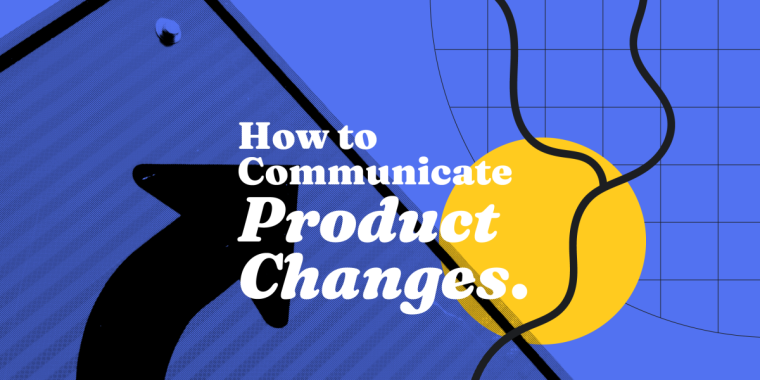No matter if you are a small startup or a huge SaaS platform with large marketing teams, launching new features is one of the key ways to add value to an existing product, differentiate from your competition, and keep your user base engaged. The way you communicate product changes to end users is actually a big task and shouldn’t be left up to fate.
Your own product management and engineering teams spend weeks or even months to finally announce product updates and working on small bug fixes. It’s crucial to communicate all of this changes effectively to keep your customers excited, your user base engaged, and show them your product progresses according to their needs.
In this article we’ll go over how to convey product changes to your users using release notes, why this should be part of your communication strategy and the best way to build hype.
Here is how to use release notes to boost engagement and growth.
What are release notes?
In the industry lingo, a release note is usually described as a “technical document” to inform about the launch or improvements of a software product or a product update (like new features, bug fixes or feature enhancements).
Release notes are commonly short, relevant, to the point, and informative. Usually written by product management.
To whom am I writing?
Each release note has a target audience. Even though the word “technical” may make it seem like release notes are just for developers and other tech-savvy individuals, these days, the main target audience is the end user.
Your user base needs to be kept in the loop, and release notes can build the bridge between a new product or new features, and your existing users.

Why you should announce new features?
Even though it seems pretty obvious, announcing new features (with release notes) should be one of the main objectives of your communication strategy and default company policy. Specially if you are a SaaS product and even more importantly, if you follow a product-led strategy.
Use release notes as a communication strategy.
In a competitive SaaS environment, with new competitors arising every day, why should users pick YOU? That’s where release notes come in to play.
Open Communication channels!
The end users of today look in any SaaS an ever-evolving and ever-improving software product. But to effectively communicate that evolution and value, you need to have the proper channels.
Customer are used to receive all kinds of relevant information through different communication channels, mostly curated by algorithms and subscriptions like social media. But most social media strategies are focused on early marketing stages (like lead generation) and your communication with existing users can get buried under a sea of posts.
The solution is to have a steady stream of release notes to ensure users will receive the good news. Every new product, all new features, any upcoming changes can be delivered in a format shorter (and punchier 💥) than a blog post, and more reliable than social media content.
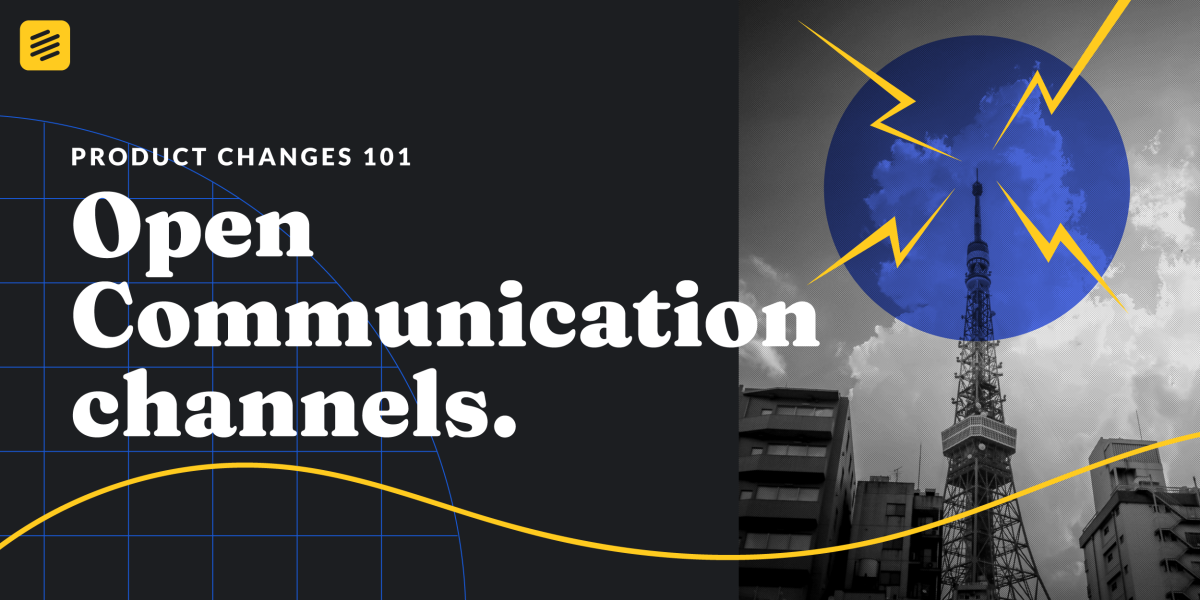
Announce product changes to engage users.
In a subscription-based model, you cannot just rely on your user base’s first purchase. You have the ongoing task of engaging your existing customers month to month.
You want to keep them coming back knowing that your team is listening to what they want and actively working to make changes.
Never look stagnant.
Without communicating product changes, they may see your product as stagnant and look for other alternatives. Don’t let your team’s hard work building a great product go to waste and lose users.
Each new release that you convey with a release note, can be the hint a customer needs to stop writing a bad review, and start testing what they were looking for.
Create a Customer feedback loop.
Now, think of a user with a specific feature need or use case.
Even if your product doesn’t have the exact functionality, the first approach to retain that user is to actually listen to their feedback and try to find the best workaround with your current offering.
That will only be useful for a while. But think of how they would feel if their request is not only addressed but solved: getting on your product roadmap as upcoming features and then announced as a release note once it’s ready to go.
That’s the Customer Feedback Loop!
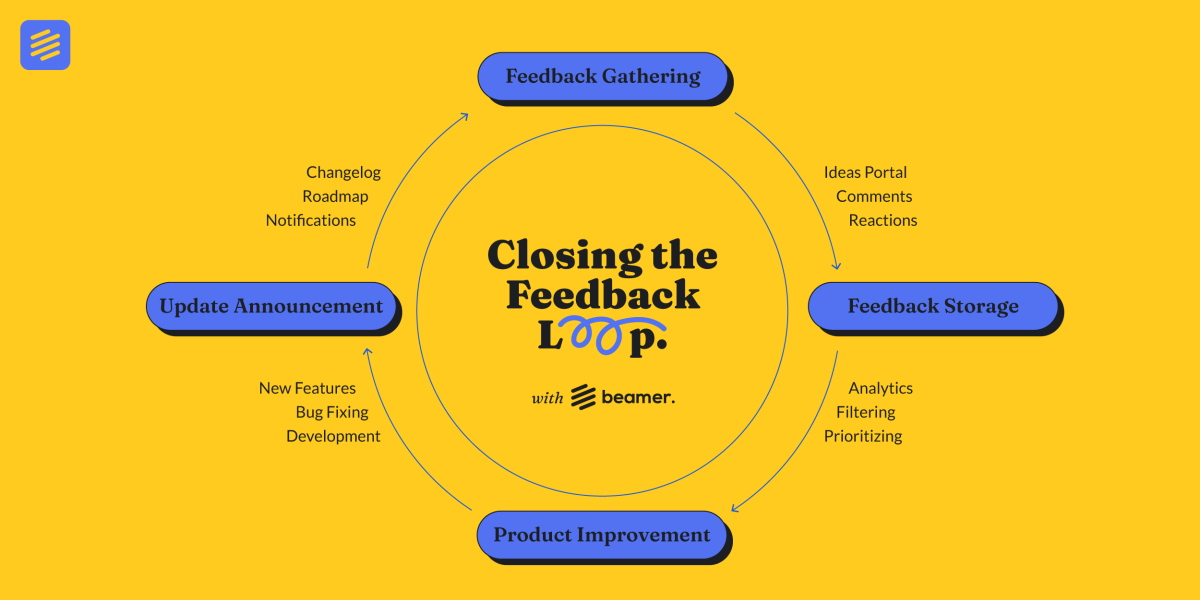
Closing the loop.
One of the main focus for your customer success team is to collect customer feedback to make sure your product’s features and UX are clear, but also to use that feedback to provide inputs to your development team for product roadmap and future releases.
Once that new functionality is released, you need to effectively communicate it to close the feedback loop and ensure your customers are aware of the feature launch.
- Gather customer feedback to understand their needs. Show interest in those needs by using a roadmap or other communication channel.
- Analyze and filter the customer feedback and forward the most urgent, popular or cost-effective matters.
- Make the product changes necessary to improve or fix the issues.
- Tell your users what you have done with a release note.
If you want to know more about this method, we have a full article all about closing the feedback loop.
Increase Product activation and adoption.
User engagement is certainly the Holy Grail of SaaS products! But first of all, you need to gain product activation.
For your new users, an effective onboarding process is vital to show value and encourage them to start using it right away.
But how do you drive product adoption with existing or inactive users? New feature releases are a great way to bring your users back and increase product usage. The secret sauce to actually see results here is to include a call to action to ensure users connect to your platform and start using the new functionality right away.
Still not sure about this? Check out how GetResponse doubled product activation by announcing their product updates.
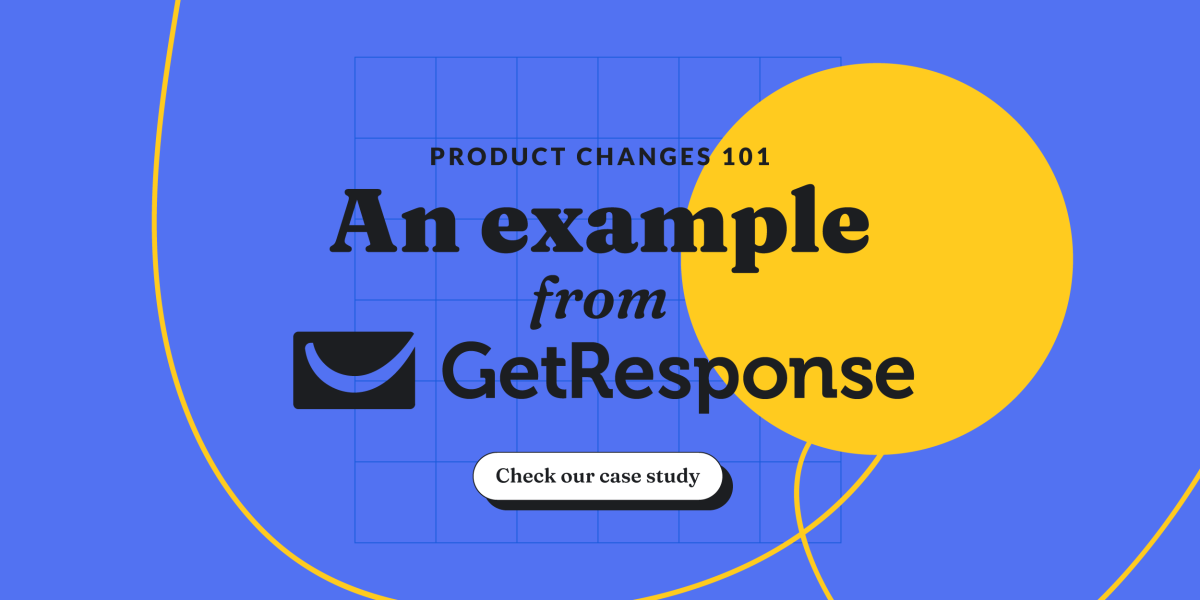
Build trust by showing your product’s evolution.
Another obvious but not so highly-regarded advantage of communicating product changes is building trust in your product.
That’s why it’s so important for product release notes to be public and easily available to new users and even to your website visitors that are still in their first steps of their customer journey.
Map the road!
Release notes are a bell that chimes with each release to let your users know what’s new.
You can still extend the power of release notes, by providing a panoramic view of all the improvements you have accomplished.
Some ways to achieve that:
- Create a timeline of your release notes that allows your users to grasp the entire development of your product changes.
- Have a public changelog with a steady stream of your latest release notes to show how it has improved and prove you are working hard while also allowing to check older release notes.
- Have a public product roadmap to show what you are planning to release next and how your product will evolve.
- Identify new releases with a name, version or release number.
- Promote each new release with time to attract users beforehand. You can use a release date (fixed, quarter or yearly) and when the next release is launched, make some noise again with a new release note.
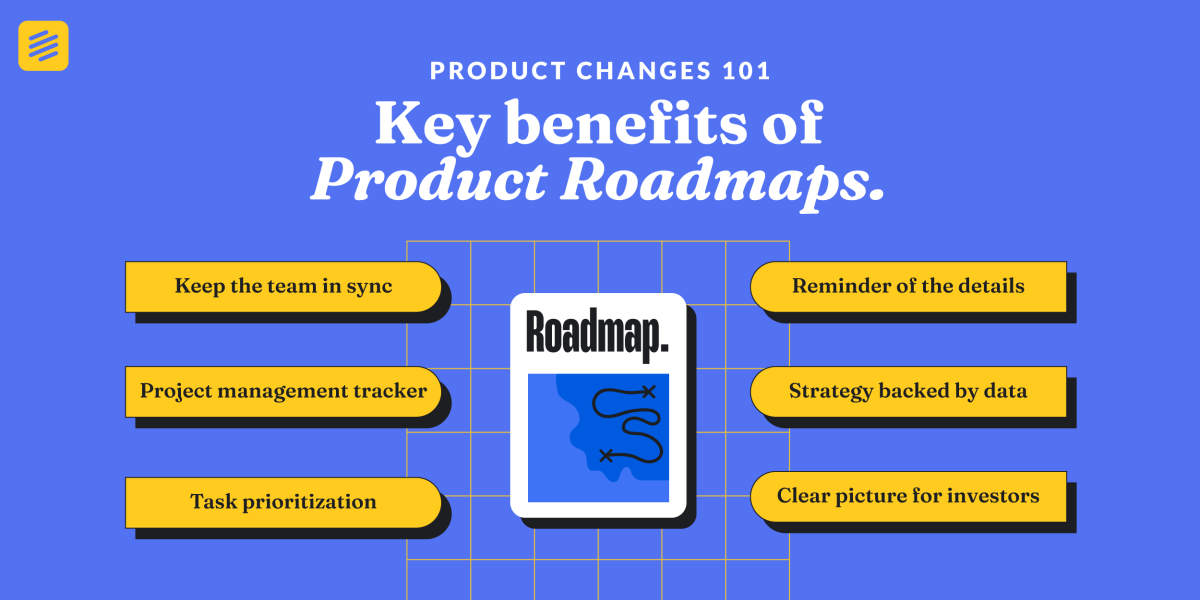
How should you write release notes?
There are several touch points along your SaaS customer journey, and it’s certainly important to be there and use different communication channels, as part of your communication strategy.
The traditional ways to communicate new features are emails, newsletters and even your company blog and posts. Of course nowadays, you should also consider social media platforms!
However, it’s even more important to have in app notifications for a next upcoming change or new feature announcement. As Aurelia Solomon, Sr Director of Product Marketing from Drift told us recently:
“Customers interact with content in very different ways at different times. Obviously we have emails, blogs, newsletters, but they are also in the product most of the time. So, it’s important that we’re messaging them in the product and allowing them to engage how they want.”
Make your release notes easy to find.
Release notes sent through a newsletter or blog post have a low open and engagement rate. In addition, their main problem is their lack of context and timing.
Most of your users will probably ignore a release note or product update by email: your users’ inbox are already full of tasks to take care of!
A different approach, would be having in app notifications of your latest releases. Having your release and engaging release notes in app is more engaging, first of all because the feature announcement great release notes is in context and your users can start using it right away.

A changelog to rule them all!
Additional, it’s important for your release notes to be easily available, not only for your entire user base, but also for your customer facing teams.
Anyone will know exactly where to find the latest news on your software product. For example, you can use a changelog tool like Beamer to notify users about your latest new features directly within your interface. Release notes inside a changelog inside your app!
Beamer is a complete feedback loop platform to collect feedback, feature requests, display your upcoming planned releases into a product roadmap and make any new release and feature announcements once developed.
Be as visual as possible in your message.
If you never write release notes and just send a text email or push notification, it’s really hard for users to really understand what changes they should look out for. To get more engagement in your release notes, they need to be short, straight to the point and specially visual!
With each release, you want to visually explain to customers what to expect and what they can do with your product. Customers are much more likely to interact and use new features and check out updates when they are visually prompted.
An image that speaks more!
Use actual screenshots, videos, GIFs, etc. to show customers changes and updates rather than just explain them. You can add photos, videos, and GIFs to your Beamer updates to better explain how to use new updates to users directly within the user interface.
It’s crucial for this visual update to be impactful! Then you can include a link to documentation or a step by step guide, for those customers who need more details detailed information on the feature.
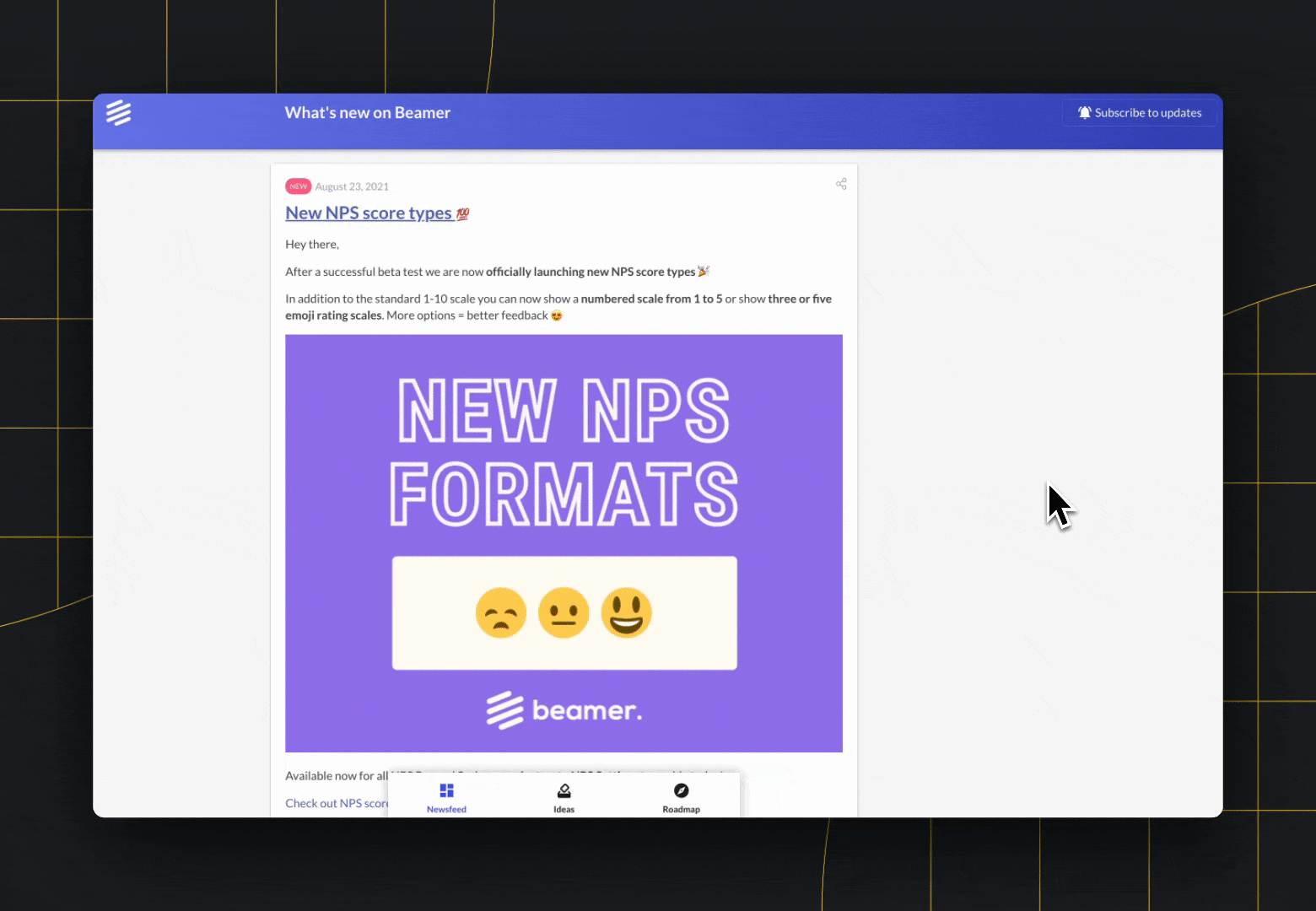
Let your customers speak!
Feedback is not the only way your customers can help you promote your release notes and news. Release notes are short and to the point, an excellent format to share in social media.
If you make your release notes “shareable” (like Beamer does), your users can promote each release through word of mouth. What better endorsement than a close friend or colleague to start using a new product?
Social proof, is a phenomenon in which people attempt to copy the behavior of others in certain situations. If a release is interesting enough, sharing it may call new leads right to you.
Give users the chance to try the new feature right away.
It means nothing to customers to just announce a new feature and hope that they will start using it regularly. Increase usage needs a concrete invitation.
You want a really quick feature adoption, and the best way to achieve this is by inviting your users to try your new feature right away.
In your release notes, give your users suggestions on how to use new features and what they can do with updates that are relevant and helpful to them. Then, at the bottom of your release have a direct link or other CTA directly to the new feature to get them started. Try this one, for example.
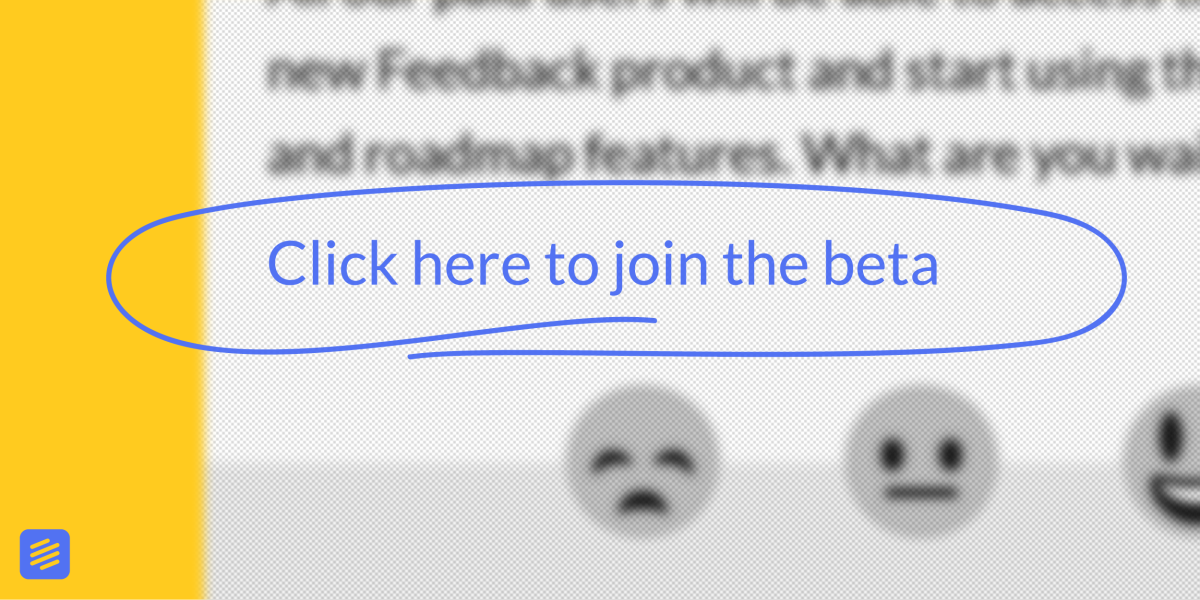
Show that you and your team are listening to what users want.
A great strategy for showing customers that you are taking their feedback seriously and are working to make your product better with each release is to specifically mention their feedback and requests in your product release notes.
If your users asked for specific functionality, thank them for their suggestion. Even while you’re working on new features and updates, let users know that you’ve heard their suggestions and you’re working on implementing them.
Showing, even on a very small scale, that your team is listening to customers and are continually working to improve the product gives your company an overall progressive and evolving image in the face of your users.
They are more likely to stay loyal to your product if customers feel that they know that what they want is on the way and their opinion is taken seriously.
Here’s an example on how we used users’ feedback at Beamer to improve the product and announce it to our customers. “Great news! By popular demand we have just launched a new version of our post editor” lets users know how important their suggestions are:
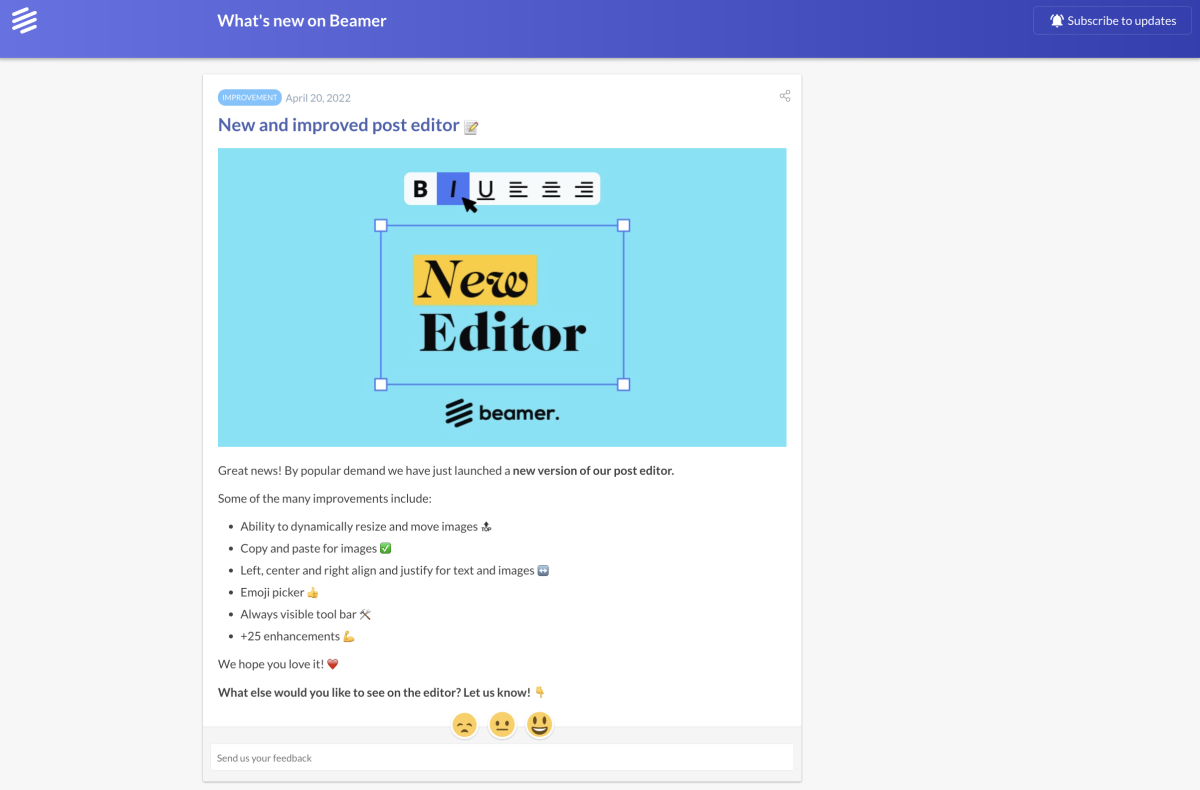
How to write better release notes?
Writing software release notes is a fine art, and maybe you need a little help to get started. You already know the whys and the basics of the how. Let’s get practical!
Be personal in your communication with customers.
Seemingly generic release notes and messages are much more likely to be ignored. Personalization is the key to getting more engagement: 78% of people prefer personalized communication. Make your announcements and updates to users personalized as well.
Identify your customer.
Different customers have different needs. Using their feedback, demographics, and all the data you can track, you can create user personas.
That is, user profiles that help you understand how to communicate with them in a language that they will understand and they’ll find engaging. User personas allow you to write targeted release notes!
You can learn more about how to identify user personas in this post.
A release note just for you!
There are simple ways to do this automatically. Using Beamer, you can segment the perfect target audience for each update. You can segment by demographic, language, user role, and even combine different criteria and create specific groups.
By sending a particular change only to the relevant users, you can avoid the alert fatigue effect and make sure your updates have a better open and engagement rate.
Additionally, you can send personalized messages, including your user’s name or company to make the update even more individualized.
Use data and feedback to measure engagement.
You cannot just guess or expect users to be more engaged just by communicating product changes. You need objective and quantitative measurements to measure success and prove it.
If you’re not measuring your customer engagement yet, here are some metrics you should be tracking. It’s interesting to check how those indicators change over time and after implementing new features. Are your users connecting more, inviting other users or upgrading more after a new feature announcement?
Another way to analyze the impact of your product changes is by collecting feedback, reaction and comments. On every release in Beamer, users can even leave their feedback, in the way of a emoji reaction and comments, only visible to you.
Combined with Beamer analytics, it’s a really simple way to quickly analyze feedback.
Give special attention to your major release notes.
Your users need to stay informed of different changes and improvements in your product: minor changes, from small bug fixes to significant product or feature enhancements and launches.
An important aspect of your communication strategy is giving these major changes a special and more appealing announcement.
Let’s say you are launching a brand new feature or product and you need some beta testers to improve the functionalities and get valuable feedback. You really want as many users as possible to be notified and sign up for the test.
Here’s when a more appealing release note is needed to grab your users’ attention. For example, you can use pop-ups, top bars, snippets or tooltips to make those release note stand out and attract your users.
Besides from in app messaging, you can also use web push notifications to catch the attention of your customers that are not currently signed in.
Don’t underestimate product sunsets or feature deprecation.
Your product is an evolving project! Not only your product managers have to take care of the upcoming changes, but also they need to keep your product lean and easy to use.
Sometimes, this mean having to say goodbye to certain features or sub products: that is feature sunset. It is then very important to start an early communication of a product sunset or feature deprecation to avoid impact in customers that are actually using them.
Make sure you provide an advanced warning to let your users know when to expect a product or feature to be discontinued.
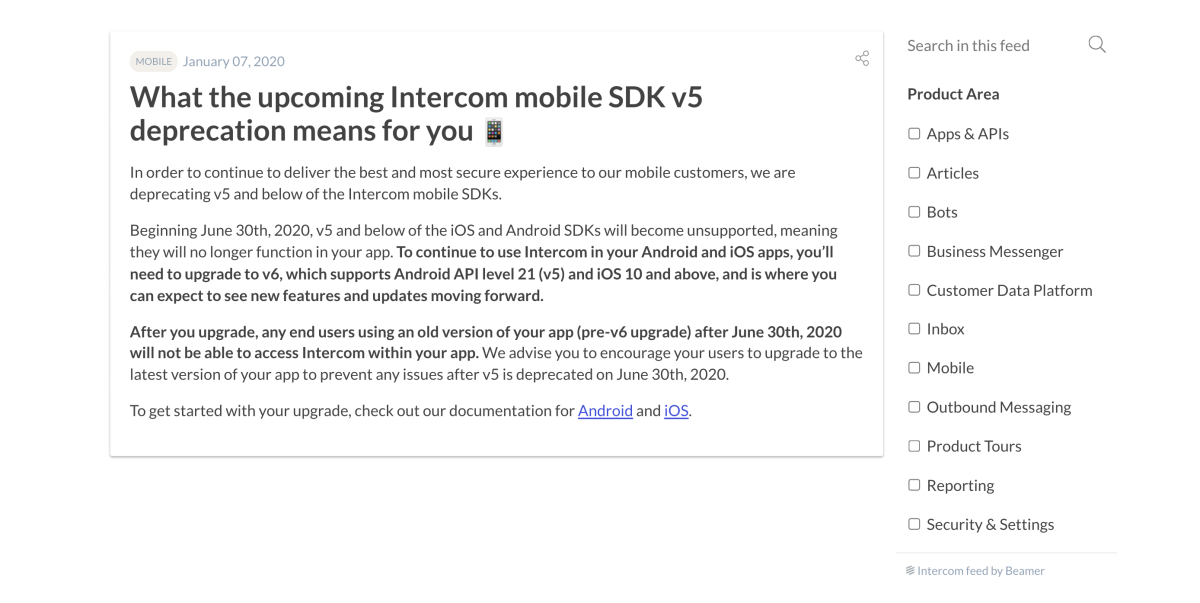
In addition, try to provide relevant information about an alternative way to solve your users’ needs and incorporate their feedback into your product strategy and planning.
In these cases, internal teams should be aligned and most importantly enable internal teams. Customer Success should be prepared to anticipate questions from impacted users and work on the best strategy to retain those users.
Even More release note resources.
If you still are unsure on how to write your own release notes, we have more resources for you.
We have published a full guide about release notes with real examples. We also have disclosed our own strategies with real-life templates to help you get started. Find the release notes template that works for you.
An effective communication strategy of announcing product changes is a huge opportunity to build loyalty, gather customer feedback and keep engagement high as you continue to improve your product.
Write release notes like a boss! For a whole product marketing platform to announce product updates and close the feedback loop, try Beamer today.
